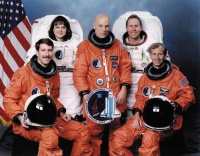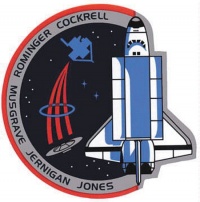STS-80
From The Space Library
 | |
| Organization | NASA-Office of Space Flight (United States) |
|---|---|
| Mission type | Human Crew |
| Launch date | November 19, 1996 |
| Launch vehicle | Space Shuttle |
| Launch site | Cape Canaveral, United States |
| COSPAR ID | 1996-065A |
| Inclination | 28.45 degrees |
| Experiments | Here |
| Alternate Names | 24660 |
| Additional Information | Here |
| Data Collection | Here |
| Payload Mass Up | 9747.24 kg |
| Payload Mass Down | 9721.36 kg |
| Orbiter | Columbia |
| Lift Off Mass | 2,056,972.73 kg |
| Orbiter Weight at Liftoff | 119,050.00 kg |
| Orbiter Weight at Landing | 103,581.36 kg |
| Landed | Concrete runway 33 at Kennedy Space Center, Fla. |
| Orbits of Earth | 279 |
| Orbital Altitude | 190 nautical miles (219 statute miles) |
Contents |
[edit] Crew
- Commander: Kenneth D. Cockrell
- Pilot: Kent V. Rominger
- Payload Commander:
- Mission Specialist 1: Tamara E. Jernigan
- Mission Specialist 2: Thomas David Jones
- Mission Specialist 3: F. Story Musgrave
- Mission Specialist 4:
- Mission Specialist 5:
- Payload Specialist 1:
- Payload Specialist 2:
ISS/Mir Crew Transport
[edit] Mission
The final shuttle flight of 1996 was highlighted by the successful deployment, operation and retrieval of two free-flying research spacecraft. Two planned extravehicular activities (EVAs) were cancelled. Orbiting and Retrievable Far and Extreme Ultraviolet Spectrometer-Shuttle Pallet Satellite II (ORFEUS-SPAS-II) was deployed on flight day one and began approximately two weeks of data gathering. It featured three primary scientific instruments: the ORFEUS-Telescope with the Far Ultraviolet (FUV) Spectrometer and Extreme Ultraviolet (EUV) Spectrograph. A secondary but highly complementary payload was the Interstellar Medium Absorption Profile Spectrograph (IMAPS). Non-astronomy payloads included the Surface Effects Sample Monitor (SESAM), the ATV Rendezvous Pre-Development Project (ARP) and the Student Experiment on ASTRO-SPACE (SEAS). The Wake Shield Facility-3 (WSF-3) was deployed on flight day 4. It was a 12-foot diameter, free-flying stainless steel disk designed to generate an ultravacuum environment in which to grow semiconductor then films for use in advanced electronics. This third flight was successful, with a maximum of seven film growths of semiconductor materials achieved and the satellite hardware performing nearly flawlessly. It was retrieved after three days of free-flight. Two planned six-hour EVAs by astronauts Jernigan and Jones were designed to evaluate equipment and procedures that would be used during construction and maintenance of the International Space Station. However, the crew could not open the outer airlock hatch and when troubleshooting did not reveal the cause, mission managers concluded that it would not be prudent to attempt the two EVAs and risk unnecessary damage to the hatch or seals. Other experiments included the Space Experiment Module (SEM) which provided increased educational access to space; NIH-R4, the fourth in a series of collaborative experiments developed by NASA and the National Institutes of Health, to investigate the role of calcium in blood pressure regulation; NASA/CCM-A, one of a series of shuttle bone cell experiments; Biological Research in Canister (BRIC)-09 experiment to study the influence of microgravity on genetically-altered tomato and tobacco seedlings; Commercial MDA ITA experiment (CMIX-5), the last in a series of shuttle experiments; and Visualization in an Experimental Water Capillary Pumped Loop (VIEW-CPL), a middeck experiment to investigate the method for spacecraft thermal management. The crew consisted of the following: Kenneth D. Cockrell - Commander Kent V. Rominger - Pilot Tamara E. Jernigan - Mission Specialist Thomas D. Jones - Mission Specialist Story Musgrave - Mission Specialist
[edit] EVA
[edit] Payload
Wake Shield Facility (WSF) 03; Orbiting and Retrievable Far and Extreme Ultraviolet Spectrograph - Shuttle Pallet Satellite (ORFEUS-SPAS) II; Inter-Mars Tissue Equivalent Proportional Counter (ITEPC) (also known as DSO 485); Extravehicular Activity Development Flight Test (EDFT) 05; Space Experiment Module (SEM) 01/Getaway Special (GAS); Physiological and Anatomical Rodent Experiment (PARE)/National Institutes of Health (NIH)-Rodents (R) 04; Commercial Materials Dispersions Apparatus (MDA) Instrumentation Technology Associates (ITA) Experiments (CMIX) 05, Configuration B; Visualization in an Experimental Water Capillary Pumped Loop (VIEW-CPL); Cell Culture Module (CCM), Configuration A; Biological Research in Canisters (BRIC) 09, Block 1; Mid-course Space Experiment (payload of opportunity)
[edit] Books about the Space Shuttle Program
Buy This Book Click here |
Buy This Book here |
Buy This Book Click here |
Buy This Book Click here |





